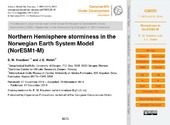| dc.contributor.author | Knudsen, Erlend Moster | eng |
| dc.contributor.author | Walsh, J. E. | eng |
| dc.date.accessioned | 2015-03-30T13:19:48Z | |
| dc.date.available | 2015-03-30T13:19:48Z | |
| dc.date.issued | 2014-12-16 | eng |
| dc.identifier.issn | 1991-9611 | en_US |
| dc.identifier.uri | https://hdl.handle.net/1956/9701 | |
| dc.description.abstract | Metrics of storm activity in Northern Hemisphere high- and midlatitudes are evaluated from historical output and future projections by the Norwegian Earth System Model (NorESM1-M) coupled global climate model. The European Re-Analysis Interim (ERA-Interim) and the Community Climate System Model (CCSM4), a global climate model of the same vintage as NorESM1-M, provide benchmarks for comparison. The focus is on the autumn and early winter (September through December), the period when the ongoing and projected Arctic sea ice retreat is greatest. Storm tracks derived from a vorticity-based algorithm for storm identification are reproduced well by NorESM1-M, although the tracks are somewhat better resolved in the higher-resolution ERA-Interim and CCSM4. The tracks are projected to shift polewards in the future as climate changes under the Representative Concentration Pathway (RCP) forcing scenarios. Cyclones are projected to become generally more intense in the high-latitudes, especially over the Alaskan region, although in some other areas the intensity is projected to decrease. While projected changes in track density are less coherent, there is a general tendency towards less frequent storms in midlatitudes and more frequent storms in high-latitudes, especially the Baffin Bay/Davis Strait region. Autumn precipitation is projected to increase significantly across the entire high-latitudes. Together with the projected increases in storm intensity and sea level and the loss of sea ice, this increase in precipitation implies a greater vulnerability to coastal flooding and erosion, especially in the Alaskan region. The projected changes in storm intensity and precipitation (as well as sea ice and sea level pressure) scale generally linearly with the RCP value of the forcing and with time through the 21st century. | en_US |
| dc.language.iso | eng | eng |
| dc.publisher | Copernicus Publications | en_US |
| dc.relation.ispartof | <a href="http://hdl.handle.net/1956/9700" target="_blank">Linking Northern High-Latitude Cryospheric Changes to Large-Scale Atmospheric Circulation</a> | en_US |
| dc.rights | Attribution CC BY | eng |
| dc.rights.uri | http://creativecommons.org/licenses/by/3.0/ | eng |
| dc.title | Northern Hemisphere storminess in the Norwegian Earth System Model (NorESM1-M) | en_US |
| dc.type | Journal article | |
| dc.description.version | submittedVersion | en_US |
| dc.rights.holder | Copyright 2014 The Authors | en_US |
| dc.identifier.doi | https://doi.org/10.5194/gmdd-7-8975-2014 | |
| dc.source.journal | Geoscientific Model Development Discussions | |
| dc.source.40 | 7 | |
| dc.source.pagenumber | 8975-9015 | |

